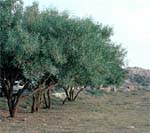|
|
In cultivation, some acacias have become serious weeds. In Australia, species such as A. saligna (Coojong), A. pycnantha (Golden Wattle) and A. baileyana (Cootamundra Wattle) have established adventive populations as a result of amenity or mine site rehabilitation plantings. As exotics, some of the worst outbreaks have occurred in South Africa, Portugal and Chile, and involve species such as A. saligna, A. cyclops (Red-eyed Wattle), A. melanoxylon (Blackwood) and A. dealbata (Silver Wattle) (for examples see New, 1984; Stirton, 1978; Whibley & Symon, 1992). Although a number of factors contribute to their weediness, it has been noted that outbreaks are worse in areas of intermediate rainfall (750-1250 mm per year) (Boland et al., 1984). Other factors that promote their spread as weeds include the production of large quantities of tough, long-lived seeds, prolific seedling recruitment following fire, and the absence of natural invertebrate predators and fungal pathogens. The potential to become weeds as exotics therefore warrants careful consideration when utilising Acacia, particularly in agroforestry situations.
References
Boland, D.J., Brooker, M.I.H., Chippendale, G.M., Hall, N., Hyland, B.P.M., Johnston, R.D., Kleinig, D.A. & Turner, J.D. (1984), Forest Trees of Australia. Nelson-CSIRO, Melbourne.
New, T.R. (1984), The Biology of Acacias. Oxford University Press, Melbourne.
Stirton, C.H. (ed.) (1978), Plant Invaders. Beautiful, but Dangerous. The Department of Nature and Environmental Conservation of the Cape Provincial Administration, Cape Town.
Whibley, D.J.E. & Symon, D.E. (1992), Acacias of South Australia. The Flora and Fauna of South Australia Handbooks Committee. South Australian Government Printer, Adelaide.
